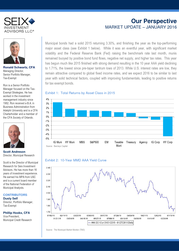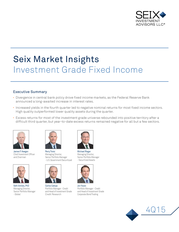Description
Credit Ratings noted herein are calculated based on S&P, Moody’s and Fitch ratings.
Generally, ratings range from AAA, the highest quality rating, to D, the lowest, with BBB
and above being called investment grade securities. BB and below are considered below
investment grade securities. If the ratings from all three agencies are available, securities
will be assigned the median rating based on the numerical equivalents. If the ratings are
available from only two of the agencies, the more conservative of the ratings will be assigned
to the security.
If the rating is available from only one agency, then that rating will be used. Any security not rated by S&P, Moody’s, or Fitch is placed in the NR (Not Rated) category. Ratings do not apply to a fund or to a fund’s shares. Ratings are subject to change. Credit Spreads are the difference between the yields of sector types and/or maturity ranges. Yield Curve is a curve that shows the relationship between yields and maturity dates for a set of similar bonds, usually Treasuries, at any given point in time. Investment Risks: Bonds offer a relatively stable level of income, although bond prices will fluctuate providing the potential for principal gain or loss. Intermediate-term, higher-quality bonds generally offer less risk than longer-term bonds and a lower rate of return.
Generally, a fund’s fixed income securities will decrease in value if interest rates rise and vice versa. A fund’s income may be subject to certain state and local taxes and, depending on your tax status, the federal alternative minimum tax. The views expressed herein are as of the quarter-end specified. This information is general in nature, provided as general guidance on the subject covered, and is not intended to be authoritative.
It is subject to change without notice as market conditions change, and is not intended to predict the performance of any individual security, market sector, or RidgeWorth Fund. All information contained herein is believed to be correct, but accuracy cannot be guaranteed. Investors are advised to consult with their investment professional about their specific financial needs and goals before making any investment decision.. Past performance is not indicative of future results. ©2016 Seix Investment Advisors LLC.
Seix Investment Advisors LLC is a registered investment adviser with the SEC and a member of the RidgeWorth Capital Management LLC network of investment firms. All third party marks are the property of their respective owners. RFRI-SEIXTX-1215 .
If the rating is available from only one agency, then that rating will be used. Any security not rated by S&P, Moody’s, or Fitch is placed in the NR (Not Rated) category. Ratings do not apply to a fund or to a fund’s shares. Ratings are subject to change. Credit Spreads are the difference between the yields of sector types and/or maturity ranges. Yield Curve is a curve that shows the relationship between yields and maturity dates for a set of similar bonds, usually Treasuries, at any given point in time. Investment Risks: Bonds offer a relatively stable level of income, although bond prices will fluctuate providing the potential for principal gain or loss. Intermediate-term, higher-quality bonds generally offer less risk than longer-term bonds and a lower rate of return.
Generally, a fund’s fixed income securities will decrease in value if interest rates rise and vice versa. A fund’s income may be subject to certain state and local taxes and, depending on your tax status, the federal alternative minimum tax. The views expressed herein are as of the quarter-end specified. This information is general in nature, provided as general guidance on the subject covered, and is not intended to be authoritative.
It is subject to change without notice as market conditions change, and is not intended to predict the performance of any individual security, market sector, or RidgeWorth Fund. All information contained herein is believed to be correct, but accuracy cannot be guaranteed. Investors are advised to consult with their investment professional about their specific financial needs and goals before making any investment decision.. Past performance is not indicative of future results. ©2016 Seix Investment Advisors LLC.
Seix Investment Advisors LLC is a registered investment adviser with the SEC and a member of the RidgeWorth Capital Management LLC network of investment firms. All third party marks are the property of their respective owners. RFRI-SEIXTX-1215 .









